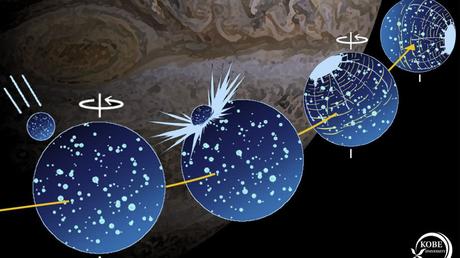A new study finds that Jupiter's moon Ganymede may have been shifted off its axis about 4 billion years ago when a massive asteroid struck the moon.
Ganymede, the largest moon in the solar system, is even bigger than Mercury and the dwarf planet Pluto. And previous research has found evidence suggesting that beneath its thick, icy crust lies a salty ocean 10 times deeper than Earth's oceans.
However, many questions remain about the moon, and scientists need more high-resolution images of its surface to unravel the mysteries surrounding Ganymede's history and evolution.
Large areas of Ganymede's surface are covered in deep grooves. They form a pattern of concentric circles around a single spot. Some astronomers believe that the moon suffered a large impact in the past.
"Jupiter's moons Io, Europa, Ganymede and Callisto all have interesting individual features, but the one that caught my attention were these grooves on Ganymede," Naoyuki Hirata, an assistant professor of planetary science at Kobe University in Japan, said in a statement. "We know this feature was created by an asteroid impact about 4 billion years ago, but we weren't sure how big the impact was and what effect it had on the moon."
Hirata is the author of a new study published Tuesday in the journal Scientific Reports that investigates what created Ganymede's groove system and the consequences of the impact. These findings can be further investigated by the European Space Agency's JUICE spacecraft, currently on its way to study Jupiter and its moons.
concentric circles around one specific spot (left, red cross). - Naoyuki Hirata" src="https://s.yimg.com/ny/api/res/1.2/jPV1hi.krJLvnkZek9to3g-/YXBwaWQ9aGlnaGxhbmRlcjt3PTk2MDtoPTU0MA-/https://media.zenfs.com/en/cnn_articles_875/49529e61567d10c7a7dbdbf9e8fb99de" class="caas-img"/>
An old impact
Ganymede has long intrigued Hirata. He said he believes revealing its evolution would be "significant." The moon's surface is a study in contrasts, with bright areas of ridges juxtaposed with grooves that cut through dark areas.
Hirata took a closer look at the system from the front on Ganymede. These grooves radiate from a single point on the moon's surface, like the concentric cracks that form when a rock hits a car windshield, he said.
Hirata noted that the central point of the groove lay along the Moon's rotational axis, meaning that something like a large impact caused a complete reorientation of the Moon.

Previous research suggested that a large planetary body collided with Pluto early in its history, rearranging the dwarf planet's ice distribution and creating a distinctive "heart" on the planet's surface. Hirata said he believes a similar scenario played out on Ganymede, with its icy shell and subsurface ocean.
A sudden change in the way mass is distributed across a planet can shift the location of its axis, or the imaginary line around which planetary bodies orbit. When a large asteroid hits a planet, it creates a gravitational anomaly that changes the way a planet spins. So Hirata calculated what kind of impact could have caused Ganymede's current orientation.
His comparisons showed that an asteroid about 300 kilometers in diameter initially created a crater about 1,400 to 1,600 kilometers in diameter.
The asteroid was 20 times larger than the one that slammed into what is now the Yucatán Peninsula in Chicxulub, Mexico, and led to the demise of Earth's dinosaurs 66 million years ago. The crater left behind on Ganymede was 25 percent the size of Jupiter's moon, the study found.
The Juice Mission Up Close Investigation
It's still unclear how much Ganymede's axis shifted, Hirata said. But future data collected by the Juice mission, or Jupiter Icy Moons Explorer, could shed more light on Ganymede's history and the impact event.
The spacecraft launched in April 2023 and completed a historic flyby of Earth and the moon on August 21. It is now on track to reach Jupiter and its moons in 2031.
It's hard for researchers to know whether an ancient impact created the grooves on Ganymede without more data, which the Juice mission could provide, said Adeene Denton, a postdoctoral researcher in the Lunar and Planetary Laboratory at the University of Arizona. She was not involved in Hirata's study.
"This paper presents an interesting starting point, with a lot to think about for the evolution of the icy moon and its ocean world," said Denton, who co-authored an April study on the implications for Pluto and its large basin, called Sputnik Planitia, which forms the left lobe of the heart region observed by astronomers.
"It's worth noting that some skepticism may be warranted when considering old, degraded geological features on planetary bodies and how they affect a planet's orientation," she said. "With so little information about these large, old features, it's difficult to be confident in identifying this feature as a basin, as well as a potential mass anomaly. Fortunately, unlike Pluto and (Sputnik Planitia), we'll be returning to Ganymede soon and can get the additional information needed to resolve this."
Researchers believe Ganymede's interior resembles a club sandwich, filled with alternating layers of ice and ocean. Understanding how the impact changed the moon could provide insight into its intriguing internal structure, Hirata said.
"I want to understand the origin and evolution of Ganymede and other moons of Jupiter," he said. "The giant impact must have had a significant impact on the early evolution of Ganymede, but the thermal and structural effects of the impact on the interior of Ganymede have not been studied at all. I believe that further research can be done on the internal evolution of icy moons."
For more CNN news and newsletters, create an account at CNN.com
